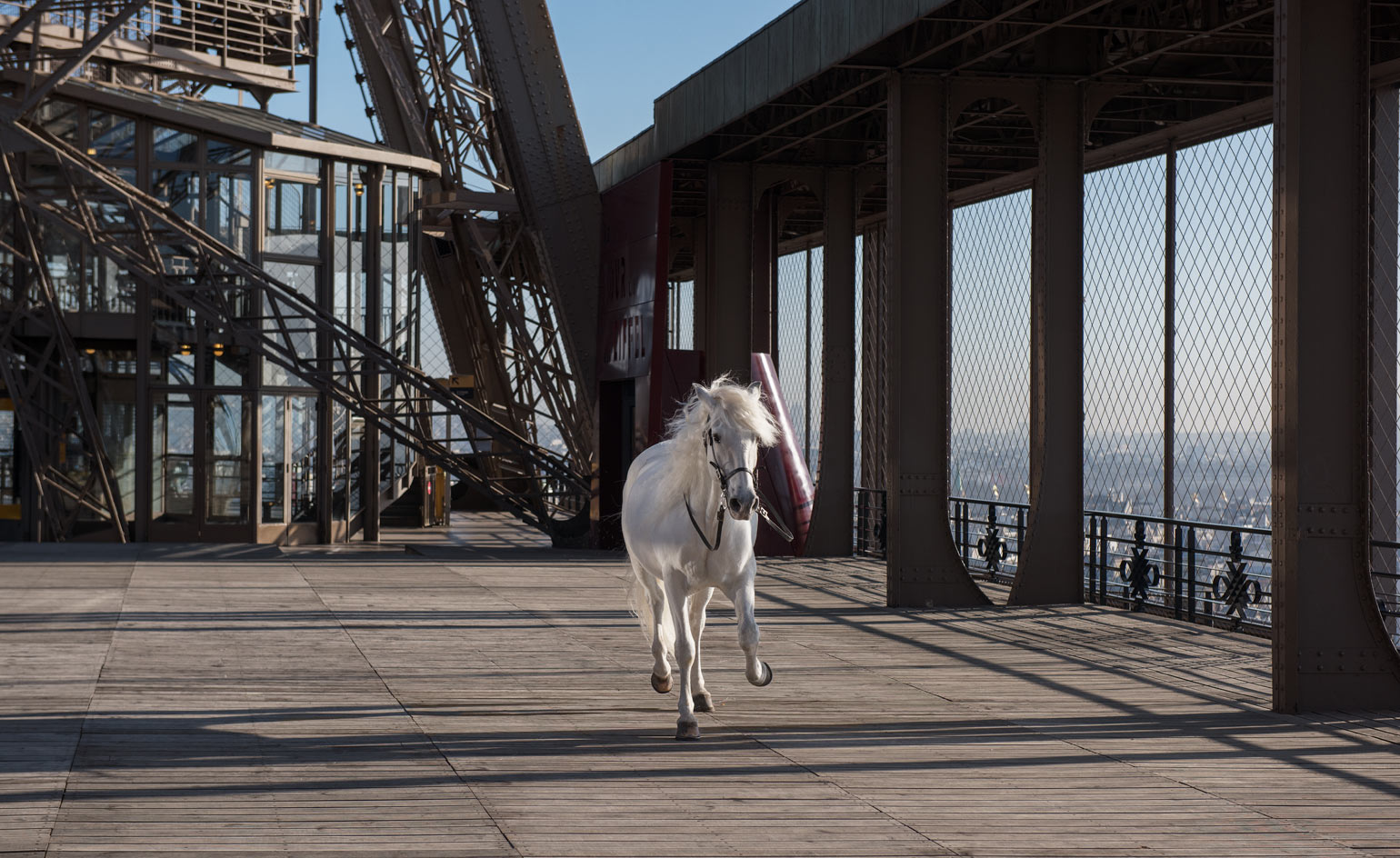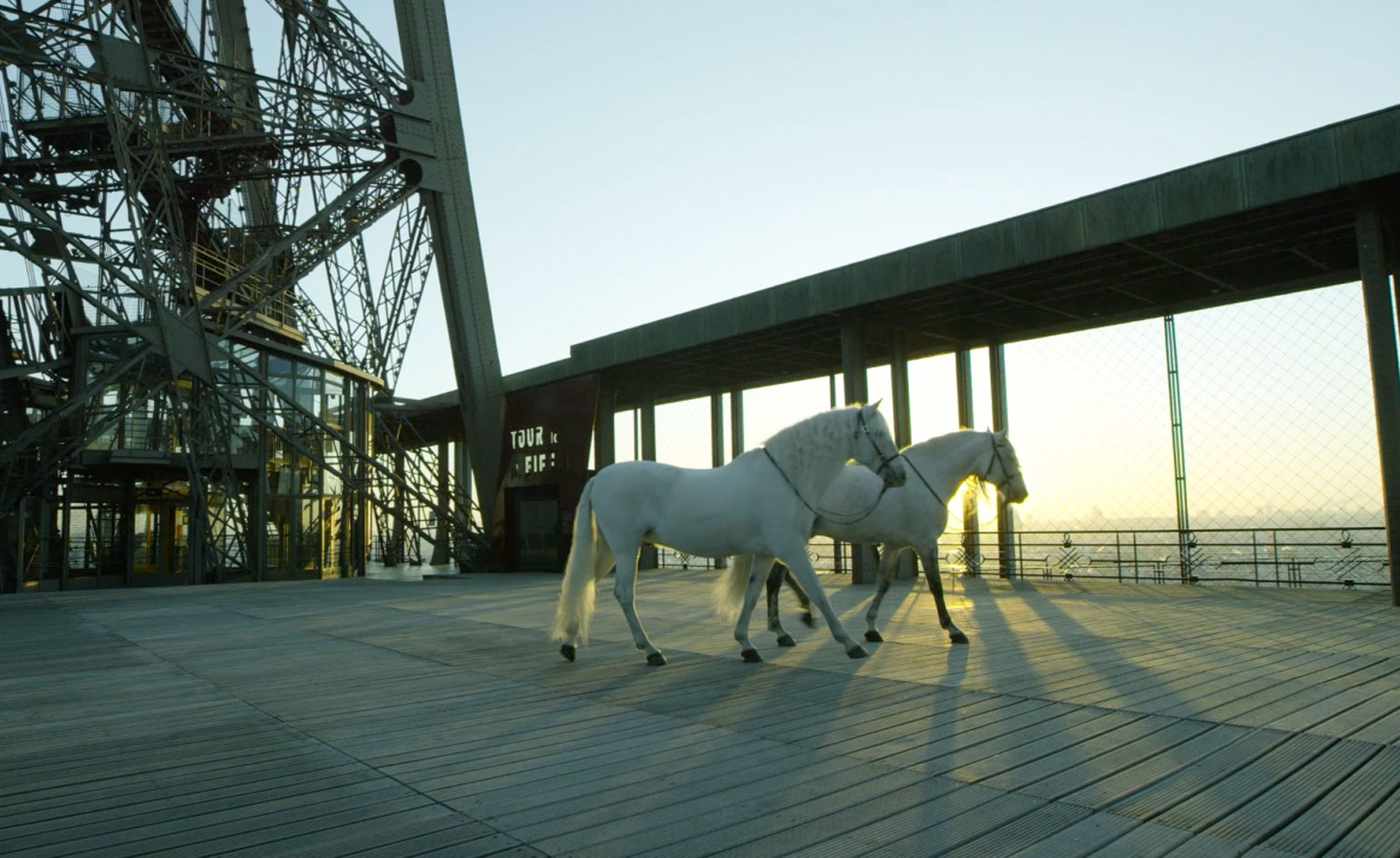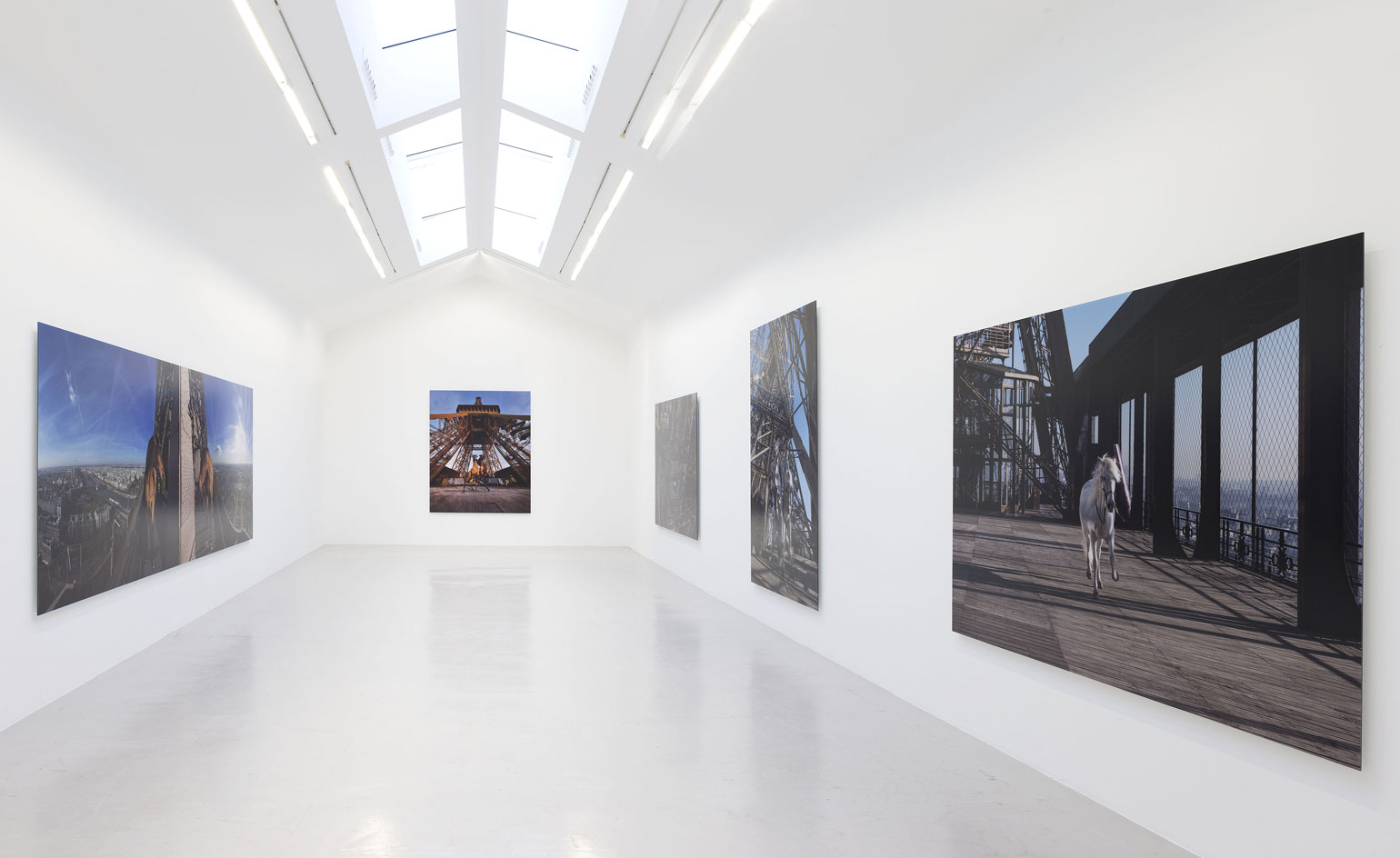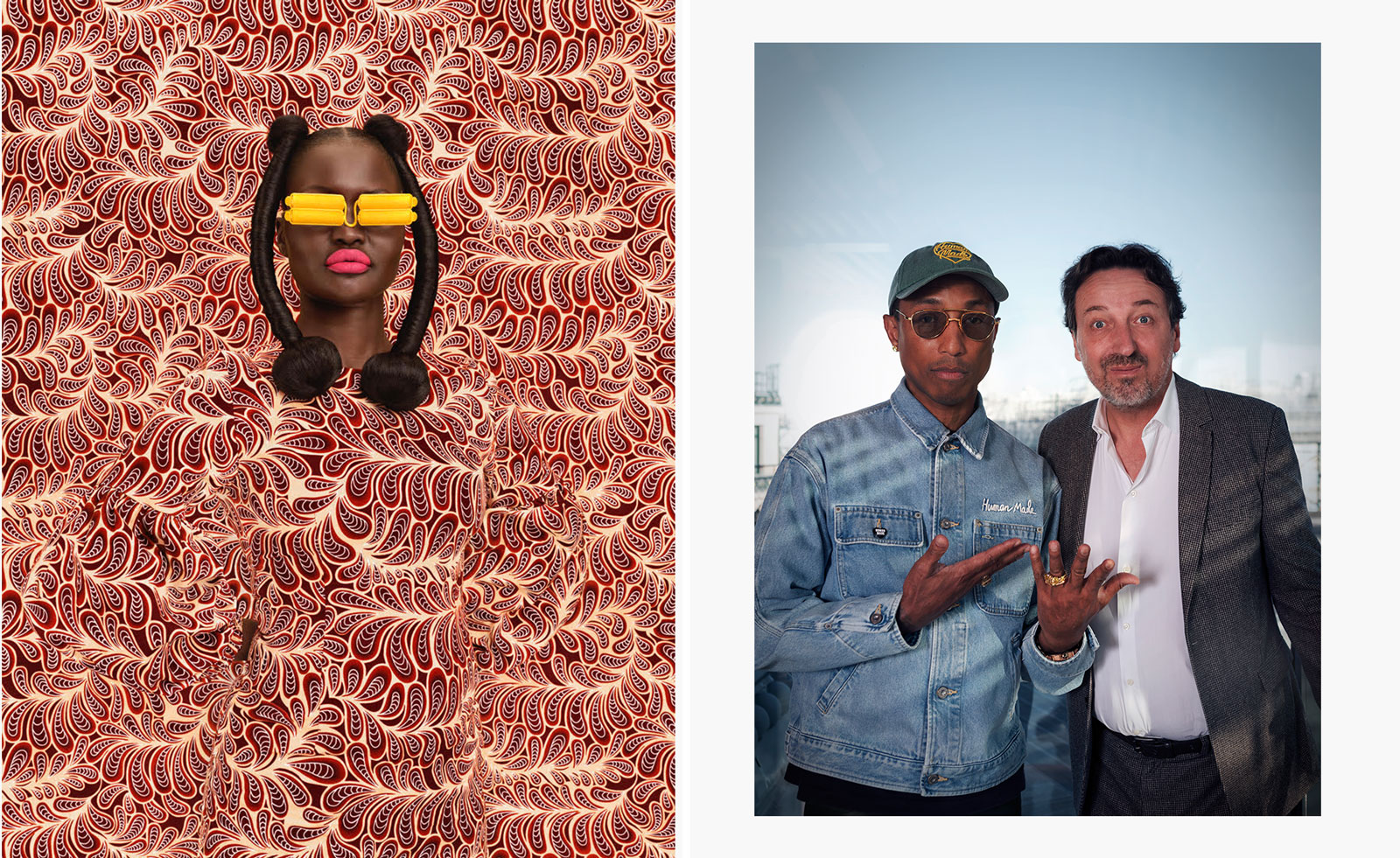Horsing around: Paola Pivi reaches new heights at the Eiffel Tower

How do you get four horses most of the way up the Eiffel Tower? In the lift, two at a time, of course. We know this for certain because the Italian artist Paola Pivi has done it. And to otherworldly effect.
'Yee-Haw', Pivi's latest exhibition at Paris' Galerie Perrotin, her ninth in fifteen years, includes five photographs of rearing horse muscle and sinew set against the tower's intricate, and still astonishing, steelworks. Again working with photographer Hugo Glendinning, Pivi captures the horses, two white, two chestnut, from a low angle in early morning light, camouflaged somehow, and entirely at home, or perhaps animal spirits generated by the tower itself.
Pivi, ignoring conventional wisdom, has often worked with animals, landing them in unfamiliar places. She has put zebras up mountains, ostriches and donkeys in boats and 84 goldfish on a plane; 'performative happenings' she records photographically, still and moving images.
Never simple protests at man's indifferent advance, though there may be some of that there, these misplacements seem to open up cracks in the known shape and order of things, to allow for fabulous alternatives. We spoke to Pavi about horses in lifts and other things...
Wallpaper*: First the practicalities of producing 'Yee-Haw': you actually got horses up the Eiffel Tower. How did you get them up there?
Paola Pivi: Actually, we just put them in the lift.
W*: Where were the horses from?
PP: They were horses trained for the film industry. They are incredibly well trained.
W*: And did they like it up there? They look like they are enjoying themselves but it's hard to imagine what a horse makes of finding themselves high above a city?
PP: Well, they were completely relaxed. Mario Luraschi, the trainer told me that these horses are trained in the same way that horses used to be trained for war; they cannot be afraid of anything.
W*: But it is important to you that these are live animals re-acting to a situation, not stuffed animals?
PP: Yes, it is a performance.
W*: It's odd how this re-contextualising of animals, putting them in these unfamiliar, remarkable environments, is so disorientating and powerful?
PP: Yes, in some cases it can highlight the design of the animal, as if there could have been a designer.
W*: And oddly they make us, the man-made environment, feel like the intrusion, not them?
PP: Yes, there is that effect too. It is as if the animals bring their whole world with them and it creates a fusion with our world.
W*: Why horses on the Eiffel Tower? I read that you had wanted to put an elephant on top of the Arc de Triumph and/or a giraffe on top La Defense?
PP: Yes, but that never happened and never will, and that's ok.
W*: And is there a link between the horses and the Eiffel tower?
PP: Sure. There is a history to this. Virginie Coupérie Eiffel, Gustave Eiffel's great-granddaughter, is interested in making sure that the tower participates in the contemporary life of the city. She feels that the tower is an artwork and shouldn't just be a symbol of the past, or a tourist attraction. She is also a champion show jumper and organises 'Paris Eiffel Jumping,' a show jumping event that happens under the tower. She has an idea to invite artists to do something with the tower. And this year she invited me. She uses the art image in the poster for the event. After she invited me, it was natural to work with horses.
W*: Funny that the tower has become this tourist attraction and icon but we forget what a startlingly modern structure it was, and in many ways still is, and how much it was fundamental to Modernism in terms of signaling this break from the past.
PP: Yes, I completely agree, especially after spending so much time with the building. It is such a tourist attraction because it is an extraordinarily unbelievable artwork.
W*: I know in the past you have talked about basing your art on 'visions' that you have. Did you see this scenario in a vision? Do you have very precise visions? And do your ideas change as you go along?
PP: Sometimes I get a very fixed image, and some times it is not so fixed. In this case it was just the idea to put the horses and the tower together. And I was open to seeing what would happen. But in other cases the idea was much more formed and I just made it happen. Like when I placed the ostriches on the boat.
W*: You are very careful to draw a distinction between the performance as a discrete thing, and the photographic record of that event.
PP: The performance and the photography and the films that I make are a completely separate art works, different mediums and different languages. When I did 'I wish I am fish', a performance with 84 goldfish flying in a passenger plane, it was particularly evident that the real fish on the airplane, and the photographs and the movie that I did, they were all different aspects of the same source. Some of these performances need to be private. If you have an audience it changes the performance in some cases. When I put the zebras in the mountains, there was no audience and there could be no audience. The only way I have to bring this artwork to other people is with a photograph. Actually there was a huge audience at the Eiffel Tower on the first day of the shooting because there are hundreds of people who work there, even before it opens, and they heard we were shooting horses on the tower and came to watch.
W*: How many pictures are in the exhibition? And are they stand-alone images?
PP: There are five images. Each is a single image that stands by itself. It was actually a very short time we could have the horses up there before the tower actually opened and there was enough light. I work with the photographer Hugo Glendinning and we shoot as much as we can and then see how many images work as art works. This time there were five. With the zebras they were three.
W*: There are shots where the tower looks almost white and matches the horses and another where there are brown horses and the tower is brown. How did you achieve that effect?
PP: The tower changes colour a lot. Sometimes it looks black, sometimes brown or light brown, sometimes light grey. The photograph just delivers what happened with the sunlight at that particular moment.
W*: And what are you working on at the moment?
PP: I will show at the Echigo-Tsumari Art Triennial in Japan which opens on 26 July. It's a brilliant show, held in a huge valley. There are permanent and semi-permanent art works all over the valley, in bus stops, in a school, on a mountain, we can really use the urban and natural environment.

Five photographs of rearing horse muscle and sinew set against the Eiffel Tower's intricate, and still astonishing, steelworks, make up Paola Pivi's latest exhibition at Paris' Galerie Perrotin. Courtesy of Galerie Perrotin

4284877616001
Watch Paola Pivi's 'Yee Haw' take shape far above Paris. Courtesy of Galerie Perrotin

Two horses standing on their hind legs, brightened by the blazing sun. Both the angle from which they are photographed and their echoed positions highlight the rigourous technique and patience achieved for this photographic composition. Courtesy of Galerie Perrotin

The tower changes colour with the sunlight, here the two white horses are shadowed by the grey graphic lines of the structure. Courtesy of Galerie Perrotin

Paola Pivi says 'I work with the photographer Hugo Glendinning and we shoot as much as we can and then see how many images work as art works. This time there were five.' Courtesy of Galerie Perrotin

'Yee-Haw (sleeping)' shows two white horses; one sleeping in an unusual environment. The stable and hay have been traded for the iron floors of the Eiffel Tower. Courtesy of Galerie Perrotin
ADDRESS
Galerie Perrotin
76 rue de Turenne
75003 Paris
Receive our daily digest of inspiration, escapism and design stories from around the world direct to your inbox.
-
 Grace Atkinson's Ukraine-made textiles balance material and emotion
Grace Atkinson's Ukraine-made textiles balance material and emotionWallpaper* Future Icons: New Zealand-born Grace Atkinson creates sensual domestic textile objects using 14th century techniques
-
 For Rodríguez + De Mitri, a budding Cuernavaca architecture practice, design is 'conversation’
For Rodríguez + De Mitri, a budding Cuernavaca architecture practice, design is 'conversation’Rodríguez + De Mitri stands for architecture that should be measured, intentional and attentive – allowing both the environment and its inhabitants to breathe
-
 A compact Scottish home is a 'sunny place,' nestled into its thriving orchard setting
A compact Scottish home is a 'sunny place,' nestled into its thriving orchard settingGrianan (Gaelic for 'sunny place') is a single-storey Scottish home by Cameron Webster Architects set in rural Stirlingshire
-
 Inside the fantastical world of performance artist, Darrell Thorne
Inside the fantastical world of performance artist, Darrell ThornePerformance artist Darrell Thorne straddles multiple worlds, telling stories through transformation, reinvention and theatrical excess
-
 ‘The Black woman endures a gravity unlike any other’: Pharrell Williams explores diverse interpretations of femininity in Paris
‘The Black woman endures a gravity unlike any other’: Pharrell Williams explores diverse interpretations of femininity in ParisPharrell Williams returns to Perrotin gallery in Paris with a new group show which serves as an homage to Black women
-
 Vanessa Beecroft’s ethereal performance and sculpture exhibition explore Sicily’s cultural history
Vanessa Beecroft’s ethereal performance and sculpture exhibition explore Sicily’s cultural historyAt the historic Palazzo Abatellis, Sicily, Vanessa Beecroft has unveiled ‘VB94’, a new tableau vivant comprising a one-time performance and a new series of sculptures, the latter on view until 8 January
-
 Subversive artist Cosey Fanni Tutti on individuality and annihilating limitations
Subversive artist Cosey Fanni Tutti on individuality and annihilating limitationsFollowing the launch of her new book Re-Sisters, we speak to Cosey Fanni Tutti about conquering fear through action, stepping into the unknown, and the secret to making art that matters
-
 Can the Marina Abramović Method change your life?
Can the Marina Abramović Method change your life?Lady Gaga and Jay-Z are among those who have followed the Abramović Method to reach higher creative consciousness. Now, the artist’s iconic approach has been translated into a series of instruction cards for all. If you don’t try, you’ll never know
-
 Ragnar Kjartansson’s dramatic soap opera inaugurates GES-2 in Moscow
Ragnar Kjartansson’s dramatic soap opera inaugurates GES-2 in MoscowIcelandic artist Ragnar Kjartansson inaugurates the much-anticipated V-A-C Foundation’s GES-2 House of Culture in Moscow. Santa Barbara – A Living Sculpture is a bold, theatrical work that examines the relationship between Russia and the US
-
 Torkwase Dyson and Mark Rothko inaugurate Pace gallery’s new London home
Torkwase Dyson and Mark Rothko inaugurate Pace gallery’s new London homeJust in time for Frieze Week 2021, Pace has opened its much-anticipated Hanover Square gallery with shows by Torkwase Dyson and Mark Rothko
-
 Anne Imhof: body language as tool, canvas and concept
Anne Imhof: body language as tool, canvas and conceptAnne Imhof is one of five radical artists chosen by Michèle Lamy for Wallpaper’s 25th Anniversary Issue ‘5x5’ project. In the midst of Imhof’s carte blanche at Paris’ Palais de Tokyo, we explore how she has redefined the concept of body language